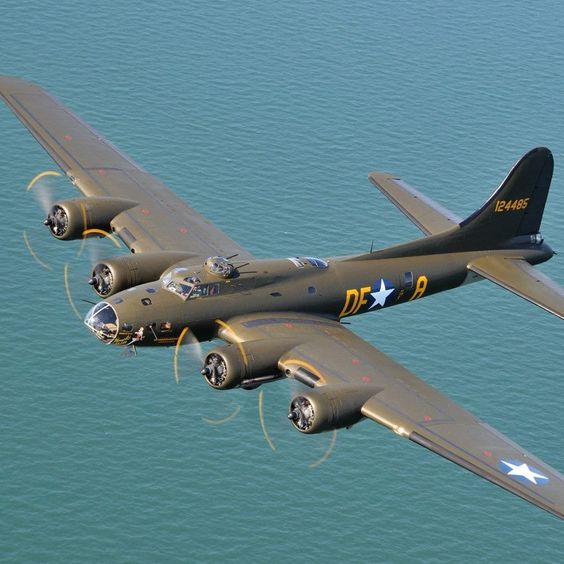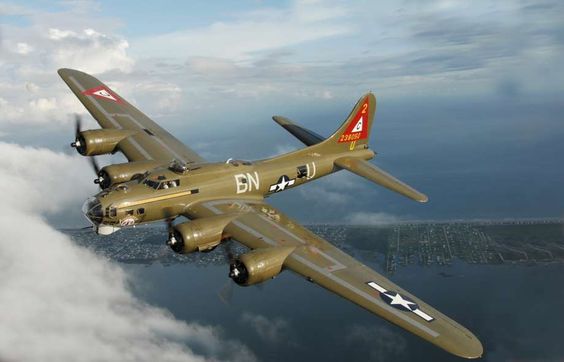5 Factors That Made The B-17 Bomber An Amazing Machine
The Boeing B-17 Flying Fortress is a timeless example of the technological innovation and skill of its day. The B-17, a representation of American air power in World War II, was dubbed the “Flying Fortress” due to a combination of its sturdy construction, strategic flexibility, powerful weaponry, resilience, and the steadfast determination of the crews that flew it. Let’s look at the five main characteristics that made the B-17 bomber such a remarkable aircraft.
Solid Design and Longevity:

The B-17’s ability to endure the rigors of battle and achieve its strategic goals was largely due to its strong and resilient construction.
Engineering Wonders:
Heavy Structure: At the time, the aluminum alloy was a cutting-edge material that gave the B-17’s airframe strength and lightweight.
Defensive Armor: The aircraft was heavily outfitted with a defensive armor plate to shield crew members from enemy fire, particularly in sensitive locations like the cockpit.
Self-Sealing Fuel Tanks: The B-17 was equipped with fuel tanks that could seal minor holes by enemy ammunition, reducing the possibility of disastrous burns.
Because of its sturdy construction and defense mechanisms, the B-17 was a dangerous aircraft that could withstand the intense rigors of air combat and successfully return its crew to base even after suffering damage.
Versatility in Strategy:

One of the main reasons for the B-17’s success was its strategic adaptability, which allowed it to be used in many different areas of action and be crucial to Allied air campaigns.
Flexible Profiles for Missions:
Precision Bombing: The B-17’s main task was to precisely attack key targets located deep into enemy territory throughout the day. It was able to attack the center of the Axis military and industrial complex because of its large bomb load capacity.
Formation Flying: The B-17’s ability to fly in close formations provided a strong defensive front against enemy interceptors, which increased its efficacy in precision bombing. This strategy turned out to be essential for both mission success and loss minimization.
Long-Range Capability: The B-17 was able to execute long-range missions, hitting targets far into Europe and the Pacific, because of its remarkable operating range. Its increased range helped make it more effective during strategic bombing operations.
Because of its versatility, the B-17 proved to be an invaluable asset to the U.S. Army Air Forces, serving a variety of vital roles that were essential to the Allied war effort as a whole.
Armament for Defense and Firepower:

The B-17 was known as the “Flying Fortress” because of its legendary firepower and defensive armament, which were unmatched in size and potency.
Arsenal Aerial:
Several Gun locations: The B-17 was equipped with several gun locations, which were thoughtfully placed throughout the aircraft. These positions included the tail, waist, ball turret, top, and nose.50-Caliber Machine Guns: The B-17 could deliver a barrage of gunfire against approaching enemy fighters thanks to its Browning M2.50-caliber machine guns.
Turreted Ball Gunner: A gunner was stationed beneath the aircraft in this unique ball turret, which protected from attacks from below, which was a weak point for bombers.
With its powerful defensive armament, the B-17 became a true flying fortress, deterring and rebuffing hostile fighters and greatly enhancing the aircraft’s survival.
Evolution and Adaptability:
Over its operational existence, the B-17’s continued effectiveness was largely due to its flexibility and ongoing innovation.
Constant Enhancement:
Upgraded Models: The B-17 had many model updates that included new developments in technology as well as lessons gained from warfare. Performance, survivability, and mission success were all improved by these enhancements.
Electronic Countermeasures: Later B-17 models were outfitted with electronic countermeasures to boost survivability and interfere with enemy radar in response to changing threats.
Operational Modifications: The B-17’s versatility allowed it to be used in both the European and Pacific theaters of conflict. Its adaptability demonstrated its capacity to satisfy shifting strategic requirements.
The B-17 was able to face the demands of changing air warfare because of its unwavering dedication to constant improvement.
Team Spirit and Resilience:
The perseverance and camaraderie of the crews that flew and maintained these aircraft were major contributors to the B-17’s success, even putting aside its technical qualities.
Human Factor:
Crew Cohesion: The B-17 crews became into close-knit groups with a great feeling of trust and friendship. Cohesion like this was crucial for productive collaboration in dangerous combat operations.
Resilience in Adversity: B-17 aircrew showed incredible perseverance and commitment in the face of frequent enemy flak threats, fighter attacks, and unfavorable weather circumstances. Their perseverance was demonstrated by their capacity to withstand adversity and maintain their focus on the goal.
The B-17’s crews’ bravery and dedication in overcoming the difficulties of aerial warfare was a defining characteristic of their human element.
In conclusion, The Legend’s Legacy
More than just a machine, the Boeing B-17 Flying Fortress was an important part of the Allied triumph in World War II, a representation of American economic and military might, and a tribute to the valor of its crews. Its strong design, tactical adaptability, powerful armament, flexibility, and the undying dedication of its crews all helped to make it an amazing aircraft. The B-17’s legacy lives on in the pages of aviation history as well as in the memories and emotions of those who understand how crucial a part it played in determining the direction of a war-torn globe.








